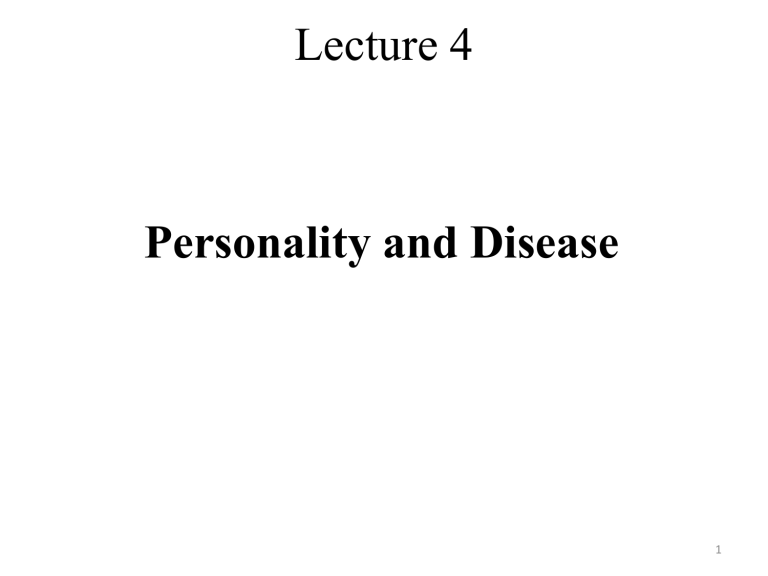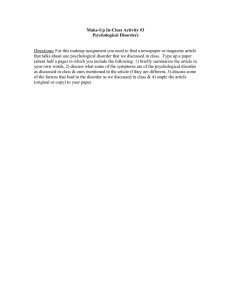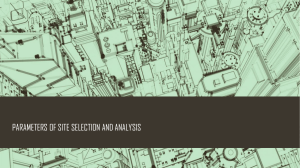
Lecture 4 Personality and Disease 1 Content 1. 2. 3. 4. Disease and health. Norm and pathology. General notions of disease as a pattern. Internal picture of the disease Mechanisms of psychological compensation and protection. 2 -1The notions of norm and pathology, health and disease are the basic vectors, which form perception system and criteria for assessing the human condition in clinical psychology Norm is used as the basic criterion to compare the current (actual) and stable (common) human conditions. Deviation from the norm is viewed as a pathology or a disease. Norm has two meanings: Statistical – this is the level of functioning of an organism or personality, which is typical for most people. Evaluative – is an ideal sample of human condition. 3 The kinds of norms: 1. Functional norms - assess a person's condition in terms of their consequences (harmful or not harmful). 2. Social norms - control the behavior of a person, forcing to correspond to some desired or established by the authority pattern. 3. Individual norms - comparing a person's state not with other people, but with the state in which a person is before and which corresponds to his personal goals, life values, opportunities, life circumstances. To assess the normality (compliance with the norm) of the psychological state of an individual, depending on the goal, any of the listed norms can be applied. 4 Any deviation from a set of norms can be viewed as a pathology or suffering. Pathology – the distortion of organism functioning (malfunction) on the biological level, the pathology is only such a deviation from the norm, when a person experiences an emotional discomfort. Together with the term pathology there is a term «disorder». Disorder means the lack or distortion of the previously existing common human condition. Disorders can be provoked by the interaction of some factors: biological, psychological and social. Any of these factors can be major at the beginning, development or in the end of the distortion, depending on the individual case. 5 The norm and the pathology (disorder) are viewed as states of health and disease at the social level of human functioning. There are two approaches to the definition of health state in science : 1. Negative definition of health views the health as the lack of pathology and it’s normality. Here norm and health are synonyms as pathology and disease. 2. Positive definition of health tries to find independent from the disease content. The common definition of health was suggested by the World Health Organization (WHO) and it means such a human state, when : 1. All structural and functional characteristics of organism are preserved. 2. There is a high adaptability to changes in comfort natural and social environment. 3. Emotional and social comfort remains. 6 The criteria of psychological health according to WHO’s definition: - awareness and feeling of continuity, constancy of your "I"; - feeling of constancy of experiences in the same type of situations; - criticism towards yourself and towards the results of your activities; - correspondence of mental reactions to the strength and frequency of environmental influences; - the ability to manage behavior in accordance with generally accepted norms; - the ability to plan your life and implement your plans; - the ability to change behavior depending on life situations and circumstances. Thus, health in general and mental health in particular is a dynamic combination of various indicators, while illness can be defined as a narrowing, disappearance or violation of health criteria. 7 -2In modern medicine, there are two models of the disease: 1) The biomedical model has existed since the 17th century. It aims to study natural factors as external causes of disease. The biomedical model of the disease is characterized by: • - theory of the pathogen; • - the concept of three interacting entities - the owner, agent and environment; • - cellular concept; • - a mechanical concept, according to which a person is primarily a body, and his illness is a breakdown of some part of the body. Within the framework of this model, a disease (including a mental one), no matter what factors it causes, always has a somatic nature. 8 2) The biopsychosocial model of the disease emerged in the late 70s of the 20th century. It is based on the system theory, in which each lower-lying level acts as a component of the higher-lying level, including its characteristics, and is influenced by it. In the center of the model is always the person with own experiences and behavior. This model is based on the diathesis-stress dyad, where diathesis is a biological predisposition to a certain morbid state, and stress is psychosocial factors that actualize this predisposition. The interaction of diathesis and stress explains any disease. Psychological factors play a leading role in assessing health status within the framework of the biopsychosocial model. Subjectively, health is manifested in a sense of optimism, somatic and psychological well-being, joy of life. 9 This subjective state is due to the following psychological mechanisms that ensure health: • taking responsibility for your life; • self-knowledge as an analysis of their individual body and psychological characteristics; • the ability to live in the present; •the ability to understand and accept others; •trust in the process of life - along with rational attitudes, orientation towards success, planning your life, etc. Within the framework of the biopsychosocial model, a disease is considered as a disorder that threatens the inability of psychobiological mechanisms to perform their functions in a certain socio-cultural space So, illness is life in changed conditions. 10 -3- Internal picture of the disease (IPD). The disease can be defined in three ways: 1. As a state of organism– the change in physical body state. 2. As a specialist interpretation– clinical diagnosis. 3. As s patient’s point of view – fullness of disease consciousness, emotional reaction. The disease consciousness is showed by the feeling of mental weakness, helplessness, suffering and mainly by the discomfort in further events development. The diagnosis and prognosis have two contrast meanings in patient’s mind: - On the one hand– diagnosis –is the danger of worst fears confirmation; - On the other hand–is hope for medical treatment and recovery. These two opposite tendencies are the basis of the patient's internal conflict, according to the internal psychological resolution, which the patient will agree or refuse to “enter the disease”, that is, whether he will seek medical help or not. 11 In the clinic of any disease, two sides are clearly manifested: -external (or objective picture of the disease); - internal picture of the disease (IPD). External is considered as a set of clinical data obtained during the examination of a patient: these are indicators of examination, percussion, palpation, laboratory, apparatus and other studies. The internal picture of the disease (IPD) is awareness, a holistic view of the patient about his disease, his psychological assessment of the subjective manifestations of the disease. IPD - explores by talking to the patient, questioning, using questionnaires. IPD is influenced by the patient's personal characteristics, both congenital (type of higher activity, temperament) and acquired (character, education, literacy level, cultural level). 12 There are several levels in IPD structure: Sensual (sensitive) - a complex of painful subjective sensations, these include: nausea, dizziness, itching, pain and other complaints. Emotional is the response, the patient's experience of individual symptoms or the disease as a whole. Intellectual- knowledge about the disease and its real assessment, the depth of awareness of the severity of the consequences of the disease. The internal picture of the disease is considered as a system of mental adaptation of the patient to his disease, which is based on the mechanisms of psychological defense and coping. 13 -4The mechanism of psychological protection The concept of the mechanisms of psychological protection was formed within the framework of the psychoanalytic direction in psychology. The concept of psychological protection was introduced by Freud and developed by his daughter A. Freud. The psychological literature presents a different understanding of this term. Psychological protection is determined: •as "passive-defensive forms of response in a pathogenic life situation", •as "mental activity aimed at spontaneous elimination of the consequences of mental trauma.“ Defense mechanisms are "adaptive mechanisms aimed at reducing pathogenic emotional stress, protecting against painful feelings and memories and further development of psychological and physiological disorders." 14 All protective mechanisms have two common features: First, as a rule, they are nonconscious, i.e. they generally take place at the not conscious stage. Second, they distort, deny or fabricate the reality. The mechanisms of psychological protection can be verified by maturity degree. So, displacement and negation are considered to be the most infantile, immature mechanisms. They are common for small children. Mechanisms of identification and isolation are typical for teenagers. Sublimation, rationalization and intellectualization are the most mature mechanisms. 15 The following mechanisms of psychological defense are most often described: 1. Repression is a mechanism of psychological defense by means of which impulses (desires, thoughts, feelings) that are unacceptable to a person, causing anxiety, become unconscious. Freud, who considered it central in the formation of neurotic disorders. 2. Denial - is unawareness (lack of perception) of any traumatic circumstance. 3. Reactive formations - replacing “Ego” - unacceptable tendencies with directly opposite ones. (For example, exaggerated love of a child for one of the parents may be a transformation of a socially unacceptable feeling of hatred towards him). 4. Regression - a return to an earlier stage of development or to more primitive forms of behavior, thinking (hysterical reactions such as vomiting, sucking fingers, babbling, excessive sentimentality, etc.). 5. Isolation - the separation of affect from intellectual functions. Unpleasant emotions are blocked in such a way that the connection between a certain event and its emotional experience does not appear in consciousness. 16 6. Identification — is the protection from a dangerous object, by identification yourself with it. (So, a small boy wants to look like his father, whom he is afraid of, trying to deserve father’s love and respect). 7. Projection - the process, by means of which non-conscious and not acceptable feelings and thoughts are located outside, they are attributed to other people. 8. Substitution - the action is shown in so to say “discharge” of suppressed emotions, usually of hostility or anger, which are directed to weaker, more helpless (animals, children, subordinate). 9. Rationalization — is person’s pseudorational explanation of his wishes, actions, which are really provoked by such reasons, which can drop the person’s self-esteem. 10. Sublimation — is psychological protection by means of desexualization of initial impulses and their transformation into socially accepted forms of activity. The inner picture of a disease is created for protective purposes in order to weaken the intensity of negative experiences, which are connected with diseases, with the compensation of the feelings of guilt, shame, aggression. 17



